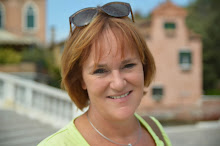You need:
- white drawing sheet
- thin cardboard 7 by 7 cm
- pencil
- scissors
- color markers
- black marker
- black construction paper for background
Use this book for your lesson: 'Nadir en Zenith in the world of Escher' by Wouter van Reek. Publisher: Leopold. EAN: 9789025876920.
Nadir and Zenith come to a place that is so strange they can’t even tell if it’s real. Their curiosity is aroused and they look further. And further. Going deeper and deeper into the weird and wonderful world of M.C. Escher, where nothing is quite what it seems. Fortunately Mr Escher helps them find their way. Or is it the other way round?
M.C. Escher
Maurits Cornelis (Mauk) Escher (1898-1972) is born in the Netherlands. After high school he goes to the graphics department of a technical college to become graphic artist. During a trip to the Alhambra in Granada he discovers the Moorish mosaics. These have a major influence on his later artwork and are the basis for this lesson.
View artworks from Escher and discuss them. Show for example the impossible buildings Belvedere or Waterfall.
Look at some pictures with animal tesselations and talk about symmetry = two objects are each other's mirror image. You can show examples of the three basic types of symmetry.
What do you see? How would Escher have made these prints? In which pictures do you see he has made different animals? And in which prints do you see the same animal? Where are the animals mirrored? Where do you see all animals heading in the same direction? Can you mention other symmetrical things?
What should you do?
1. Take a piece of cardboard from 7 by 7 cm. Draw a shape on two following sides and cut them out.
2. Stick the cut pieces on the opposite site of the cardboard with tape. Make sure the distance from the edges is the same.
3. Trace this shape with a pencil on a drawing sheet. Move the shape and trace again.
4. Fill up your sheet completely, so also with half animals along the edges.
5. Search for an animal in the shape. Draw details.
6. Choose two colors and color the animals alternately. Outline the shapes with black marker and draw details with the black marker too.
7. Stick your artwork on a black sheet.














